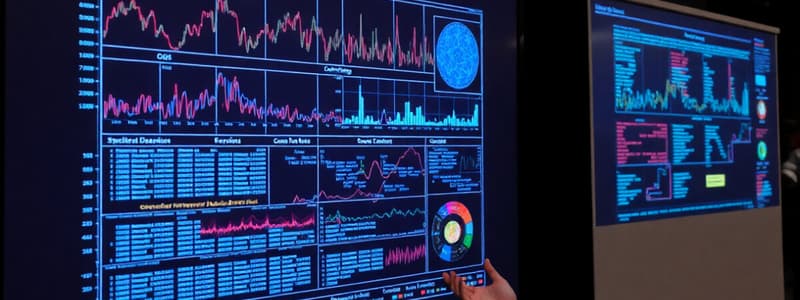Podcast
Questions and Answers
What is the advantage of using pictorial representations in scientific writing?
What is the advantage of using pictorial representations in scientific writing?
- They take up less space than text.
- They are always more accurate than written descriptions.
- They replace the need for written explanations.
- They can simplify complex data for better understanding. (correct)
When should a line of best fit be used in a graph?
When should a line of best fit be used in a graph?
- When showing individual data point variations.
- When assessing correlations between variables. (correct)
- When creating bar charts or pie charts.
- When all data points are exactly aligned.
Which type of graph is best suited for displaying data over time?
Which type of graph is best suited for displaying data over time?
- Pie chart
- Line graph (correct)
- Bar graph
- Scatter plot
What should you consider before including a diagram in your work?
What should you consider before including a diagram in your work?
Which statement about graphs is true?
Which statement about graphs is true?
How should symbols be handled when presenting mathematical data?
How should symbols be handled when presenting mathematical data?
What is a key benefit of using graphs compared to tables of data?
What is a key benefit of using graphs compared to tables of data?
What is the primary purpose of scientists presenting their data?
What is the primary purpose of scientists presenting their data?
Which medium is primarily used by scientists to share research findings with other scientists?
Which medium is primarily used by scientists to share research findings with other scientists?
When addressing a public audience, which method is often preferred for presenting scientific data?
When addressing a public audience, which method is often preferred for presenting scientific data?
Why is it important to acknowledge sources in scientific presentations?
Why is it important to acknowledge sources in scientific presentations?
What is a common practice for referencing sources in scientific writing?
What is a common practice for referencing sources in scientific writing?
Which of the following is NOT a typical way to present scientific data?
Which of the following is NOT a typical way to present scientific data?
In scientific literature, how are complex relationships often best expressed?
In scientific literature, how are complex relationships often best expressed?
What might the introduction of a scientific publication include?
What might the introduction of a scientific publication include?
Flashcards
Presenting Scientific Data
Presenting Scientific Data
The process of sharing scientific findings with the scientific community and the public.
Selecting Media
Selecting Media
The medium used to share scientific data, such as scientific journals, presentations, or talks, depending on the audience.
References Page
References Page
A list of sources used in a scientific publication, acknowledging previous work and giving credit to others' contributions.
Acknowledging Sources
Acknowledging Sources
Signup and view all the flashcards
Formulas & Symbols
Formulas & Symbols
Signup and view all the flashcards
Scientific Journals
Scientific Journals
Signup and view all the flashcards
Communicating to the Public
Communicating to the Public
Signup and view all the flashcards
Lab Reports
Lab Reports
Signup and view all the flashcards
Pictorial Representations
Pictorial Representations
Signup and view all the flashcards
Graphs
Graphs
Signup and view all the flashcards
Line Graph
Line Graph
Signup and view all the flashcards
Line of Best Fit
Line of Best Fit
Signup and view all the flashcards
Bar Graph
Bar Graph
Signup and view all the flashcards
Scatter Plot
Scatter Plot
Signup and view all the flashcards
Pie Chart
Pie Chart
Signup and view all the flashcards
Study Notes
Presenting Scientific Data
- Scientific investigations gather data about the natural world, often with applications in medicine, technology, or renewable energy.
- Scientists share findings through scientific papers, presentations, and talks.
- Data is not just emailed; it's presented in a structured format.
Selecting Media
- The method of presenting data depends on the audience.
- Scientists publish in scientific journals for other scientists.
- Students might use a similar format for lab reports.
- At conferences, scientists may use slideshows or videos.
- Scientific information must be conveyed to the public using clear methods like videos, diagrams, or news articles.
Acknowledging Sources
- Acknowledging prior work is crucial, even if you produced all data.
- Introductions of scientific publications often outline previous research.
- References of previous work are needed for accuracy and proper attribution.
- Citations in the text refer to specific sources in the references section (using author's name and publication date in parentheses or numbers matching references).
Using Symbols and Formulas
- Using symbols and formulas often clarifies relationships better than simply writing out words.
- This is particularly relevant for mathematical or computational parts.
- Symbols used need specific and clear definitions in the writing.
Pictorial Representations
- Visual aids like diagrams and graphics can greatly enhance understanding complex processes or data.
- Pictures are helpful when describing complicated signaling pathways or anatomical parts.
- Consider if a picture adds unique value over text, whether there's a mental image while you explain data, and whether it helps readers unfamiliar with your content.
Graphs
- Graphs highlight relationships between variables effectively.
- They reveal trends not easily seen in data tables or written descriptions (e.g., trends over time).
- Specific graphs (line, bar, scatter, pie charts) suit various data types.
- Line graphs show trends over time, can connect points directly, or show a line of best fit to assess correlation between variables or to define equations between them.
- A line of best fit is useful with varying data tending toward a trend.
Studying That Suits You
Use AI to generate personalized quizzes and flashcards to suit your learning preferences.




